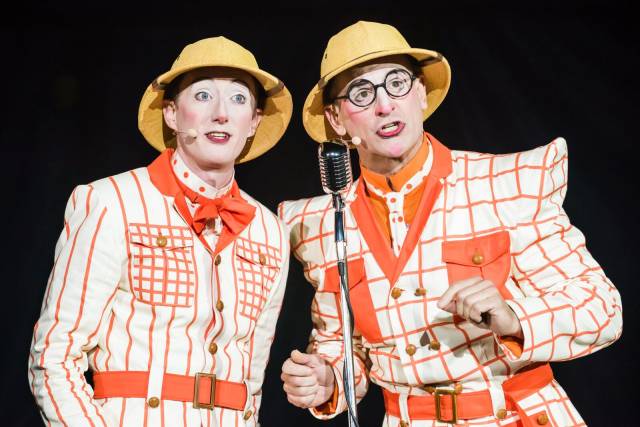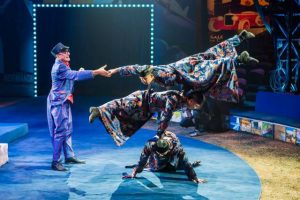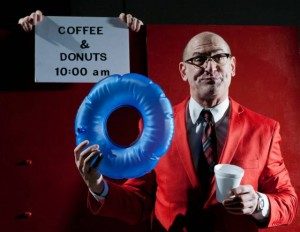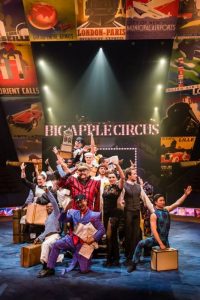

What’s a circus without the clowns? Clowns fill the ring with their quirky energy and humorous antics. In the case of the new Big Apple Circus show, there wouldn’t even be a circus without one particular clown: Joel Jeske. Jeske created and wrote the show, and also performs in it as a clown along with fellow Parallel Exit member Brent McBeth. I spoke with Jeske about his inspiration for the show and its theme, The Grand Tour, his comedy “diet,” and a certain arachnid who loves the holidays.
Watching the Big Apple Circus last week was so much fun, I was immediately taken back to my childhood, when I would go to the circus with my family. The two clowns, you and Brent McBeth [of Parallel Exit], however, don’t look anything like the clowns of my childhood, with the big red noses and those large colorful wigs. How do you modernize the art of clown for this generation of kids?
Specifically, with Big Apple Circus, how the clown looks is always a question of size. In other words, the farther away, in terms of the circus, you are from the performance, the broader a clown’s costume needs to look. So when you go to big spectacles like a three-ring circus, that’s why you’ll see clowns in outrageous clothes with gigantic shoes and crazy wigs, because they want to be able to be seen from a very long distance away. Big Apple Circus is a very intimate one-ring circus. As a result, we don’t necessarily need as bold a makeup. What we call clown makeup in the Big Apple Circus is “clown light.” The only thing that would really distinguish us as a clown is maybe rouge on our cheeks, a little rouge on our nose, a comic attitude, or a slightly louder costume than other people in the circus. At the Big Apple no one is more than 50 feet away, so when you’re that close, you really don’t need a lot to signify to an audience that you’re a clown.
Right, I noticed that the space was very intimate. I guess when I was a kid it just looked so much bigger.
At the same time, in terms of clown now, the performance is very much the same: the movement the humor, the skills, the pantomime, the gag writing, and the storytelling still have to be there. The difference is that now with the change in how people deal with each other, a lot of things are television based, and everything is much more immediate. So even though there are clowns that I know, and even if I am asked to do a very broad clown look, the nature of clown humor itself has changed. Really broad slapstick is looked upon with nostalgia now. You know, clowns climbing out of a clown car and things like that are more considered tradition than comedy. Now, audiences have been exposed to so many more different levels of humor, everything from sitcoms to especially cartoons, so when you have to introduce a funny idea as a clown, especially in a circus, you got to get to the point quick and perform it in a way that’s going to be understandable to everybody. And now a subtler approach seems to be really the way we are able to be most successful in getting our acts across.

And that, I suppose, makes it more accessible to a broader audience, adults and children alike.
Yes, for example, one of the most effective things I do as a clown at the Big Apple Circus, that both Brent and I do, is when we go out 10 minutes before the show starts and we just say hello to people. We learn their names and we welcome them to the circus, and we’re not necessarily doing comedy as much as we’re simply saying hello, making friends with the people who arrived. So when they see us later in the ring, we already have made some kind of connection and a personal interaction with the audience, which ultimately makes our job easier because they already know who we are. A very important thing that Big Apple does is that the focus is the audience; in other words, the circus performers are always reaching out with their eyes and gestures, and use their performance to befriend and treat the audience as the most important person in the room. So something as simple as learning somebody’s name, doing a handshake and getting a high five before the show starts, I feel that it’s some of the most important performing you can actually do.
Yeah, I immediately felt at home in this intimate environment, and I really enjoyed seeing everything so up close. It was really interesting in that way. I also really loved the concept of The Grand Tour as a theme for the circus. I thought it really elevated the show and made it accessible and enjoyable to both adults and children. How did you first conceptualize this version of the Big Apple Circus?
I think you said it best in the sense that we want everyone to feel comfortable and feel at home. When people go to Big Apple year after year after year, it was because they wanted to visit with Grandma the Clown, they wanted to see Mr. Paul the Ringmaster again. The people in the circus literally became their friends. That being the case, Big Apple developed a reputation for being very hands on, homemade and not very high tech. So even though we do incorporate modern technology in doing our show, we primarily hide it for the sake of giving the circus a very traditional feel. When I came up with the theme of The Grand Tour, the idea was—because our spectacle is based on our performers, it’s based on our acts, it’s the costuming, it’s the music, it’s not necessarily explosions and laser light shows—I wanted to come up with a theme that suggested and incorporated movement and speed, and something that excites everybody. In terms of adult audiences and older audiences, travel now is still the thing that everybody dreams about, the thing that everybody wants to do, and it’s insanely easy to travel now. At the same time, from a younger audience point of view, what child does not like seeing an antique train or antique car? There’s a certain point where cars and trains and boats are a bit of an obsession with children. The Grand Tour traditionally was literally sending somebody off to experience all the world had to offer. It used to be a young person with a chaperone that would go around the world. Eventually, it evolved into backpacking for college students once they left college. Now a lot of people once they hit retirement are going on grand tours on cruise ships, taking the Orient Express, and doing those trips that they’ve always wanted to do. It’s that spirit of adventure that I wanted to blend with the fantasy and excitement that surrounds the circus. By focusing on the transportation, we were able to give the show that speed that allows us to focus on the performers in the ring rather than having to try to overwhelm the audience with protection screens and pyrotechnics.
I can definitely identify with that spirit of adventure and wanting to travel the world. I love travel so this show really spoke to me because of that. And I loved all the vintage posters and especially the jazz music. Does music play a large part in your clown acts?
Yes, because music can make or break a clown act. One of the first things you learn as a clown is you choose a musical instrument because the thing that music teaches you is an internal sense of timing. It teaches you how to, especially when playing with other musicians, listen outside of yourself, how to blend with what other people are doing. Before I became a clown, I knew the piano and the alto saxophone. Once I embraced my career as a clown, I also picked up the trombone, the tuba, the soprano saxophone, the baritone saxophone, the ukulele and the banjo. Not only did I want to have that skill, for me each one of those instruments has a particular comic musical voice, and they put you in different places when it comes to clown acts. For example, for this show in particular, the music that we’re drawing from is from this composer named Leroy Shield, who wrote all the music for Laurel and Hardy and The Little Rascals at Hal Roach Studios back in the '20s and the '30s. So even in our choice of music we’re alluding to classic comedy, which at the same time is also in the style and period of what we’re doing. That’s the kind of research and depth that you’ll get. It might sound like fun, appropriate clown music, but there is going to be someone in the audience who is going to be like, “Wait a minute, that’s Laurel and Hardy music!” Or someone is going to sit there and go, “I know that from a Little Rascals movie I saw.” So being able for us as clowns to allude to that and to give reference to it in our act gives what we’re doing, I think, a greater sense of depth, and at the same time really trying to maintain a physical comedy tradition that I don’t want to see go away. It’s in my own way, and in Brent’s own way, us trying to keep the clown world alive.

Let’s hope that it does. I saw [Parallel Exit’s] Everybody Gets Cake! earlier this year and loved it! Such a silly, zany show, but really whip smart. Where and how did you develop this sort of silly, smart comedy?
At the end of the day, I have to do something that makes me laugh. My natural sense of humor is quickly becoming out of date, because what I grew up on was classic comedies like the Marx Brothers, Laurel and Hardy, and cartoons like Warner Brothers, you know Bugs Bunny and Daffy Duck, very much informed my sensibility, along with comedy shows like SCTV, which used to be on NBC, and early Saturday Night Live. We used to watch Laugh-In religiously. I’ll sit there and watch The Honeymooners marathon on WOR on New Year’s Day because I still find all that very funny, and it also comes down to a reference level. One of the best comedy teachers I ever had, because before I became a clown I was an improviser in Chicago—I worked with the Second City and the ImprovOlympic—and one of my mentors, if you want to put it that way, was a guy named Del Close. The thing about Del Close was that he ultimately said, anytime you perform comedy, you have to treat the people onstage, the other people you’re performing with, as geniuses and poets, and you naturally have to assume when you walk out on stage that the audience, in terms of their reference level, is smarter than you are. There’s always this desire, even if I’m doing clowning in the ring in the Big Apple Circus, there are certain reactions, there are certain subtleties that I might try out on the audience to really make it known that I’m not playing down to the audience, I’m playing up to them. In other words, I’m giving them the respect to make them know that. Circus clowning can be reduced down to explosions, screaming and running around. If I’m going to do something physical, I might try to make my reaction a subtle reaction, I might do a slow take for the audience to try and get sympathy; it’s trying to play smart comedy even in a very broad place. That’s what I always aspire to. When we do Parallel Exit shows, we really aim to find a simple comic idea, and if we find it we go, “Alright, how much farther can we go, how much deeper can we go, where are the levels in it that can apply to it whether it’s just happening in the minds of the audience, or whether it’s intentional or not." That’s why improv, especially with Brent and with Parallel Exit, initially is very important because when we conceive our shows, it always starts out of a conversation that makes everybody laugh. Once we tap into it and got all our senses of humor in sync, then the format and the theme and the style of the show comes together.
Did you also curate the acts for the Big Apple Circus? I know you wrote and created the show. Who brings in the different acts? Who organizes and curates that?
Of course the show had to have a written script. I have a very long history with Big Apple Circus. I’ve worked with them in various ways through Clown Care and their after-school program, and Circus to Go, so I’m familiar with what Big Apple Circus usually does. When you’re conceiving a circus, especially around an idea like this, you say to yourself, “Okay, well if a show is going to go to the deserts of Arabia, that would be perfect for Arabian Stallions.” So suggestions were made as to, you know, let’s have a hula hoopist, let’s have either a flying trapeze or a teeterboard act. So I made these suggestions based on the show. At Big Apple, you always have to have a juggler, you always have to have a hula hoopist, you always have to have a dog act and a horse act. These things, like putting together a variety show, there are certain go to acts that you would need as opposed to just going out into the world of circus acts and finding things. In that way, the style or the type of act was very specific. The Artistic Director, Guillaume Dufresnoy, and the director of the show, Mark Lonergan, actually went to the Monte Carlo Circus Festival last year, and at same time Big Apple has people at the office who receive videos and video links because Big Apple is so respected internationally, people want to work for the circus and so they submit their acts for consideration for upcoming years. In terms of Mark and Guillaume’s job, it was simply a question of which act are they going to pick. Are they going to pick a hula hoopist from South America or do we like this French hula hoopist? When it comes to who to hire it comes down to Mark and Guillaume. In terms of what acts are in the show, that was my suggestion in the initial circus script.

Was there a conscious effort to make sure it was an international cast?
Yes, because we were going around the world! That’s one thing also that Big Apple Circus prides itself on is having an international cast and being able to bring in people from around the world. That’s why in divisions of Big Apple, we have different tiers. The tent show draws from an international circus community. The programs that Big Apple has like the Circus To Go program, the after-school program and the Clown Care program, draw from circus artists that live and work locally. There’s a huge circus education that’s going on in New York right now with trapeze schools and clown classes and pole-dancing classes and that type of stuff. People are able to work and submit themselves to the Big Apple Circus even if they don’t necessarily end up in the tent show. And that way we feel very much a part of the community here in New York and we’re able to bring in local artists to work in various events or even inside many of our programs.
That’s wonderful, I really like that commitment to the community that Big Apple Circus has. What’s next, what’s after the Big Apple Circus for you?
Parallel Exit is putting together their next season of things that they’re going to do. Once the circus takes its break in January, Mark, Brent and I, and the members of Parallel Exit, are going to put on a couple more productions. Our change this year is, rather than working project to project, we’re now creating a season, and we’re reaching out to a number of New York artists who we’ve always wanted to work with and who thankfully have always wanted to work with us. So we’ll be putting news out about that.
On a personal front, I and my partner, Emmanuel José, who is a paper-cutting artist, have just come out with a children’s book. The book is called Boris The Christmas Tarantula. It’s about a giant tarantula who loves Christmas. The joke of the book is that, as much as everybody embraces Boris for his love of Christmas and his amazing talents at celebrating the holiday, he’s still a giant tarantula! The dilemma of the book happens when an army of spoiled brats revolt and demand Christmas without behaving well over the course of the year, so Santa Claus, in his infinite wisdom, sends Boris out into the world to find the good in all children. The twist of the story is that, whereas Boris approaches these children with the love of Christmas and joy and happiness and good feeling, the children just see a giant tarantula, so they are literally scared straight into behaving for the Christmas holiday. That’s kind of our twist on the macabre is that the intention of Boris is very good but people can’t get past his appearance. So of course he saves the day and gets to drive Santa’s sleigh on Christmas Day. And because Emmanuel is a paper-cutting artist, the illustrations are a reference to Christmas windows, so all of the illustrations have this three-dimensional depth to them. So you have this frame and then you look into the picture and there are layers. I think the illustrations are beautiful. But don’t take my word for it! If you go on Facebook and look up “Boris The Christmas Tarantula,” you can see some illustrations and we posted a couple of announcements. The book is in pre-order right now and it’s going to be available online through Amazon and in Barnes & Noble stores on November 20.
The Big Apple Circus performs The Grand Tour at Lincoln Center through January 10.